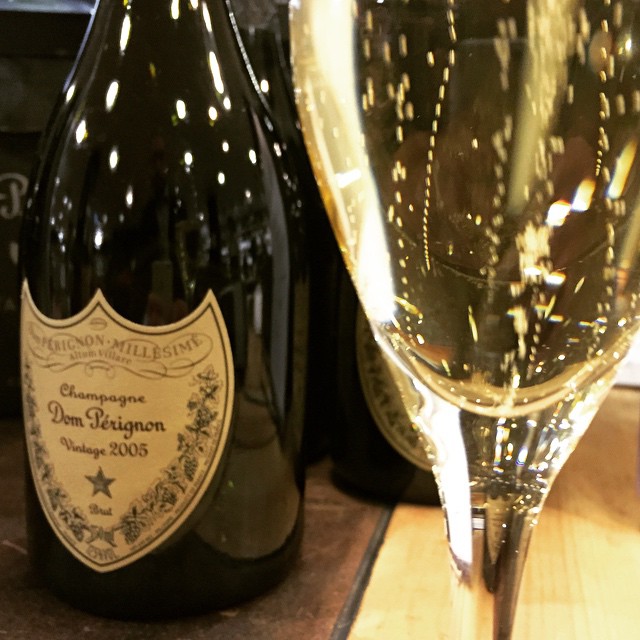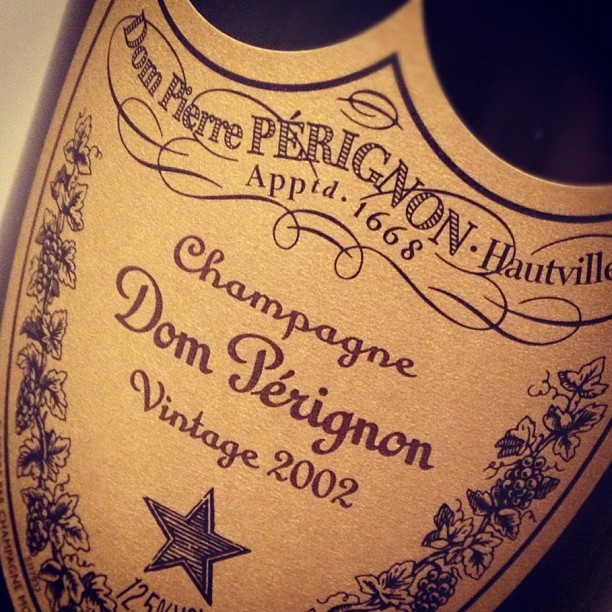Home » Blog » Wine & Drink »
UPDATE DECEMBER 22, 2015: WOW! Hello, Google Search User! This little thought piece on Dom Perignon 2005 has exploded in popularity lately. Be adviced that this is somewhat of a long read. If you want only the review and tasting notes, you can click here. Otherwise feel free to enjoy the rest of the article and the site.
Sometimes life just turns out to your advantage. A few weeks ago, I was on my way to Copenhagen and just as my train pulled into the central train station, images like the one below started popping up on various social media channels.

Tasting 2005 Dom Perignon at Mad&Vin In Magasin in Copenhagen. Quite a bargain to have a whole glass for DKK 95. Bottle price is 1199. I like it 🙂 – Quote and credit: @mikkelsmadblog.dk on instagram.com.
How lucky is this, I thought? On my way through town, I was planning on dropping by Otto Suenson Wine Store to pick up a bottle of wine before heading to a networking dinner. The particular wine outlet was right on the way. A quick decision was made, and a bit of a detour in my busy schedule was easily allowed for. So, I dashed through the streets of Copenhagen as quickly as I figured fitting for a young man in full business attire and soon found myself in the “treasure room” department of an underground wine store in Central Copenhagen looking at vintage bottles of Krug and Romanée Conti amongst others while a generous flute of beautiful bubbles sparkled away in my left hand. I was ready for my first meeting with the Dom…
What’s that, you say, I’ve never had Dom Perignon? Me? Johan? The ultimate lover of life, gastronomy, fine wine and luxury? Well, sadly, no, I haven’t. I’ve had a lot of Champagne, but never a Dom Perignon. Dom Perignon, you see, belongs in the upper echelon of Champagnes, amongst those known as Prestige Cuvées: a unique selection of the best (and most expensive) wines that Champagne producers have to offer.
Cuvée Prestige: The Soul of Champagne
Most producers in Champagne will have a selection of cuvées (types of wine) ranging from relatively inexpensive non-vintage wines over slightly more expensive vintage wines to the sometimes shockingly expensive yet often absolutely wonderful Prestige Cuvées which are usually only made in really good years and in very limited quantities, often elaborately named and bottled. Famous examples of Prestige Cuvées include Cristal by Louis Roederer, Cuvée Sir Winston Churchill by Pol Roger as well as Bollinger’s RD selection. And then, of course, there’s Dom Perignon, produced by industry giant Möet & Chandon, which, despite being in the “inexpensive” end of the Prestige Cuvée scale still retails at around $150-200 on the Danish market these days. At launch, that is.
Vintage vs non-vintage: Confused by the difference between vintage and non-vintage Champagne? A vintage Champagne is made solely from grapes harvested in one single year, that are made into wine, bottled, cellared and eventually released bearing the name of the year (vintage) the grapes were harvested. A non-vintage Champagne, in return, may be made from several different wines from various years that are carefully selected and mixed to create a consistently enjoyable drinking experience that remains the same year after year. It is interesting to note that while a non-vintage Champagne is technically harder to produce because of the mixing and matching process, it is usually seen as inferior in quality (and price) to it’s vintage counterpart because single year wines age better and often develop in interesting (and often unpredictable) ways over the years. Non-vintage wines, in turn, are (with few notable exceptions) meant for quick consumption and a steady, predictable drinking experience.

Words to live by, my friends, words to live by!
The price tag alone makes Prestige Cuvées a rare treat, helped along by the aura of sophistication and special occasion that surround them. Adding to the scarcity and rare treat factor is the fact that most Prestige Cuvées, Dom Perignon included, are produced only in limited quantities in particularly good years when the respective cave masters deem their wines worthy for release. Though to be honest, that seems like every other year for Dom Perignon these days, and their average release is probably limited in the millions (of cases) rather than thousands.
This scale of production aside, and the fact that Dom Perignon is produced by Möet Chandon – a Champagne house (in)famously known for treasuring quantity and drinkability over quality and character – blatantly ignored, Dom Perignon still has a reputation for carefully crafting quality wines made to please, impress and bedazzle. And they do so in relative secrecy despite being one of the world’s biggest brands. In fact, very little is known about the Dom Perignon production process. We know that at least two million bottles of the stuff is produced per year. We also know that the grapes used are Chardonnay and Pinot Noir, usually in a near 50/50 ratio. But that’s about it for the production process. Aside from that, we know, too, that it was the world’s first Cuvée Prestige, first produced in 1921 and that since, a total of 41 vintages has been produced. The 1921, I hear, is excellent by the way. Lastly but certainly not least-ly, we know that a lot of Dom Perignon was poured on the date of my birth, 29 July 1981, rumour however has it that the real reason for several magnum bottles of Dom Perignon 1961 being popped were the wedding of the Prince of Wales and Lady Di, not the birth of Johan the Food Blogger. But I digress…
In short, while Dom Perignon is indeed a big brand, it is still highly expensive, highly treasured and highly sough after. So, when a chance is had to dance with the Dom at a reasonable price, well of course, this food blogger steps up to the challenge. And with that, let’s put an end to this detour and return to the cellar under Magasin Du Nord and ask our reporter in the field: Just what is it like to taste a $200 bottle of the world’s arguably most famous and hyped Champagne for the first time?
Well, do you want to know the truth? The answer, from the bottom of my heart, is: strangely underwhelming! Now, don’t get me wrong, the 2005 Dom Perignon is by all accounts a beautiful piece of work, both in terms of color, bubbles, smell and taste. It’s straight forwardly fruity, clean cut and immaculately balanced. The thing is, it’s just not terribly structured, surprising or complex. No, sir, not at all. For what easily translates into $20 per glass in retail prices, you’d sort of expect to be blown off your feet or challenged. At least a little. I would, at least, and that just didn’t happen. Au contraire, you’re left with a feeling that you’ve just had an incredibly well-crafted glass of Champagne, but not a terribly unique or exciting one at that.
For what it’s worth, I could easily see why the Dom is widely loved, admired and appreciated, but I honestly expected more from my first dance with him. But that’s putting it all a little shortly, let’s have a slightly more in-depth look at the Dom Perignon 2005 based on my tasting notes from the day:
Dom Perignon 2005: A Review
At first glance, Dom Perignon 2005 sports an attractive, bright greenish-golden color. The bubbles are plentiful, small and rise rapidly to the surface in twirling little streams – a tell-tale sign of a well-crafted Champagne. Aromas are primarily of subdued fruit with a bit of a lemony/chalky whiff. The taste easily mimics the nose with even more primary and surprisingly light fruit coming through, along with a hint of toast and a bit of yeast. With a bit of air and heat, a light mineral note and a hint of complexity pushes through but the power and complex structure you would expect from a massive Champagne is just not there… At least not yet.

Dom Perignon 2005, in all his sparkling glory!
Dom Perignon is an immaculately balanced, pleasing and refreshing glass of Champagne, well-made and definitely luxurious. For a tough year like 2005 where a lot of grapes turned overly sweet or succumbed to rot, it’s certainly not a bad effort. But a monumental effort it is not and sadly that is not reflected in the price which continues to rise year by year. To be honest, what with Prestige Cuvées usually only being produced in spectacular, worthwhile years, you’re sort of left wondering why Möet & Chandon, who produces their luxury bottlings only in better years, even declared a 2005 vintage for Dom Perignon. The answer to the question may be that they think with time it will turn spectacular (in which case the joke is on me), but it might also well be more simple and straight-forward: because people will buy it!
For now, in recognition of the fact that Dom Perignon 2005 is after all a terrifically crafted if slightly one-sided experience, I’ll score it an even 90 out of a 100 points. With room to improve.
Thirsty for more? Also check out: Check out my recent post Champagne reviews: 2002 Dom Pérignon Tasting Notes for a review of the fabolous and famed 2002 vintage of Dom Pérignon
But hold on, despite this luke-warm reception from yours truly, there may still be hope for Dom Perignon Vintage 2005 and for the Champagne lovers and resellers alike who are currently busy stacking case by case of the stuff. Maybe time, as we’ve so often seen before, will be kind to Dom Perignon Vintage 2005 and break the primary fruity notes down into complex, yeasty, buttery, toffee or cream-like aromas in the years to come?
Cellaring Champagne: Will good things come to those who wait?
A worthwhile addendum about many Prestige Cuvées, you see, is that they are quite simply usually not at their optimum drinking stage at the time of their release. Quality Champagnes are some of the world’s most long-lived wines. They can literally live for decades, some say centuries, in the bottle and develop new flavors, aromas and characteristics with time. Flavor development takes time and it’s all part of the game. Since producing and cellaring vintage Champagne is by no means an inexpensive process, most producers usually release their vintage specimens after a period of eight or ten years in their cellars and leave it to wine lovers to decide whether to pop them at the time of purchase or cellar them for a few years (or decades). The reason for this is two-fold:
1) It gives the Champagne lovers a chance to taste the young wine and re-taste over the years, tracking the development.
2) It frees up space and capital for next year’s production.
Most Champagne producers and Champagne lovers alike are aware of and accept the fact that most vintage Champagnes and all Cuvée Prestiges are nowhere near their peak at the time of release. Some producers (Salon most famously) will even stress this fact by producing bottles that are downright unapproachable in their youth and *need* a few years in your private cellar to be even remotely approachable. Others will aim to produce wines that are enjoyable at launch but will improve considerably with time. One such “other” producer is Dom Perignon who are in the peculiar situation of having to produce a product that caters to quality conscious cellaring aficionados and rich kid clubbers alike. In other words, it needs to be fresh, lively and drinkable at the time of release to cater to the hungry in-crowds, but it also needs to be able to store and evolve positively for a number of years if not decades. And that’s not an easy task for a wine maker.

On a good day, I’d take three Pol Rogers over one Dom Perignon. Probably not this size, though.
Dom Perignon 2005 is the perfect example of a Champagne that is drinking pretty beautifully at the time of release and undoubtably it will continue to improve considerably over the next five to ten years if not slightly longer, developing deeper notes and more character. It does, however, lack both body, structure and acidity, three characteristics that usually define Champagnes built for the long haul and as such doesn’t strike me as one for the ages. I may be wrong, of course, basing this on a single tasting, but if I were to pick a bottle to last me a few decades or more, I’d probably go with a more solid vintage like 2004, 2006, the much-hyped 2002 (that’s actually still hiding in my personal cellar) or the mythical 1996. If I wanted something that was enjoyable now or in the next ten or so years to come, I wouldn’t mind another glass of the 2005. As long as someone else is paying 🙂 If I were paying myself, I would probably use the money on a couple of decent vintage Champagnes from a respectable producer instead, or possibly better yet, three non-vintage varieties from the likes of Pol Roger or André Roger.
Price vs Quality: Are Prestige Cuvées really worth it?
The questions I received the most from friends after I told them about my experience with Dom Perignon were pretty much in line with the questions I generally receive when people hear about my expensive wine habits. They were variations of the following: “C’mon, Johan? $200 for a bottle of wine? Is it worth it? Really?”
And that’s a tough one to answer truthfully. $200 is a lot of money any which way you look at it and a lot could be bought for said money. So, does it make sense blowing it on a bottle of wine? From a rational point of view, honestly, no, probably not. But feelings are never quite rational. And the feeling you get when you pop that $200+ bottle of wine and share it with someone you love, that moment forever etched in time, the sheer joy and beauty, it’s hard to put a price tag on.
As far as Champagne goes, the best purchase in most cases, would arguably be a regular vintage Champagnes from a good year. A luxury cuvée is usually at least twice the price of a regular vintage Champagne and does not always deliver twice the pleasure. That being said, there is something beautiful, hedonistic and majestic about popping the cork on a well-aged luxury cuvée on very special occasions. And when they deliver, they sure as hell deliver, offering finesse, beauty, character and impressions unlike anything you’ve ever had before – not to mention a glimpse into the very soul of the Champagne house and chief winemaker alike. And for those intangible reasons alone, I shall return to the Dom and his luxury brethren every now and then, never mind the price tag. I am a lover of life and luxury after all.

Dom Perignon 2002 – A Legend In The Making?
And as stated earlier, I do actually have a bottle of the famed 2002 vintage Dom Perignon waiting for me in my cellar that I am looking forward to trying. For now, though, I’ll stick to my “regular” 2002 vintages.
More wine and drink? Check out my latest reviews!
[latest_post type=”image_in_box” number_of_colums=”2″ number_of_rows=”1″ order_by=”date” order=”DESC” number_of_posts=”2″ category=”wine-and-drink” display_time=”0″ display_comments=”0″]
Pingback: Gastromand x Champagne: Dom Perignon 1996 - Stairway To Heaven - Gastromand.dk